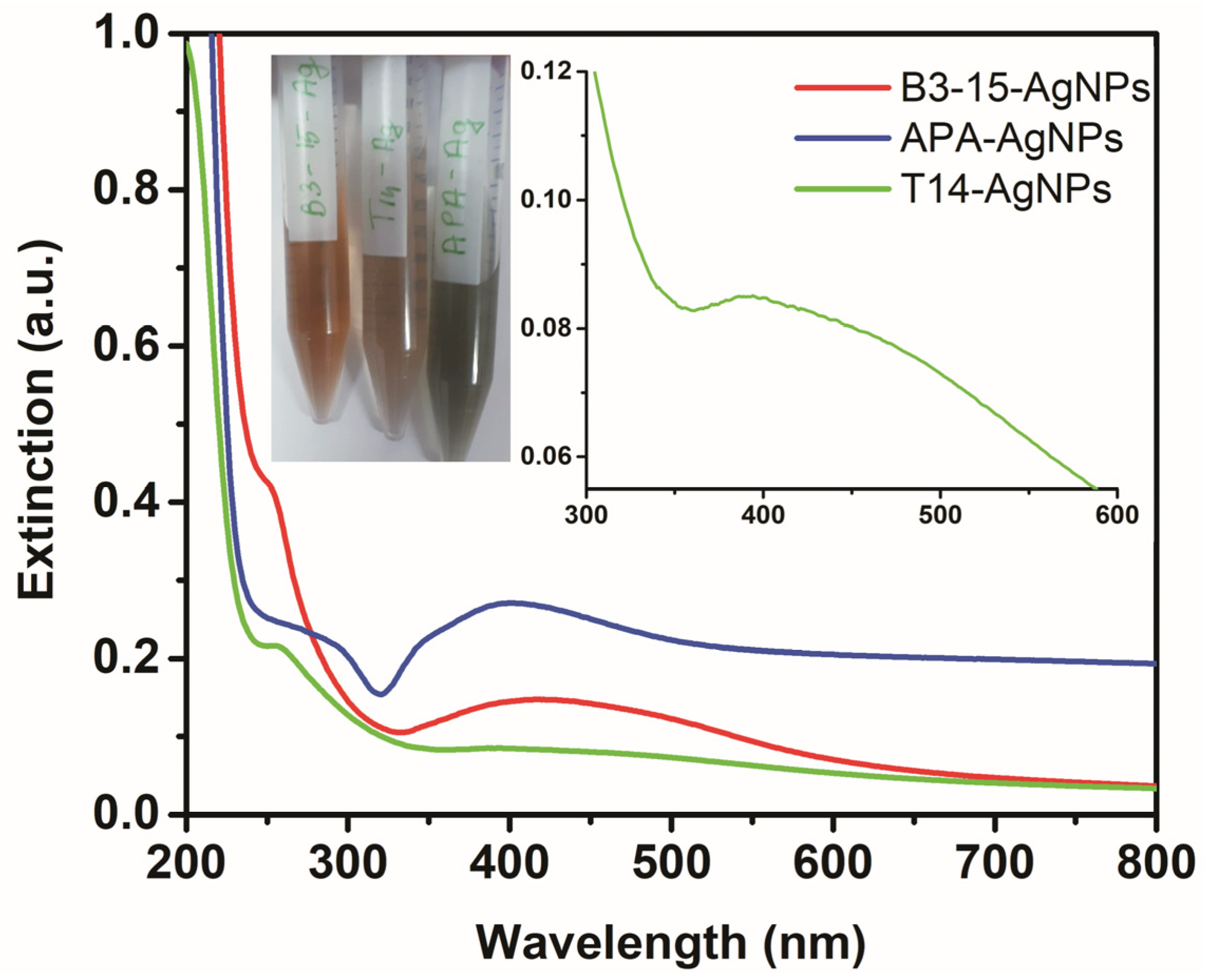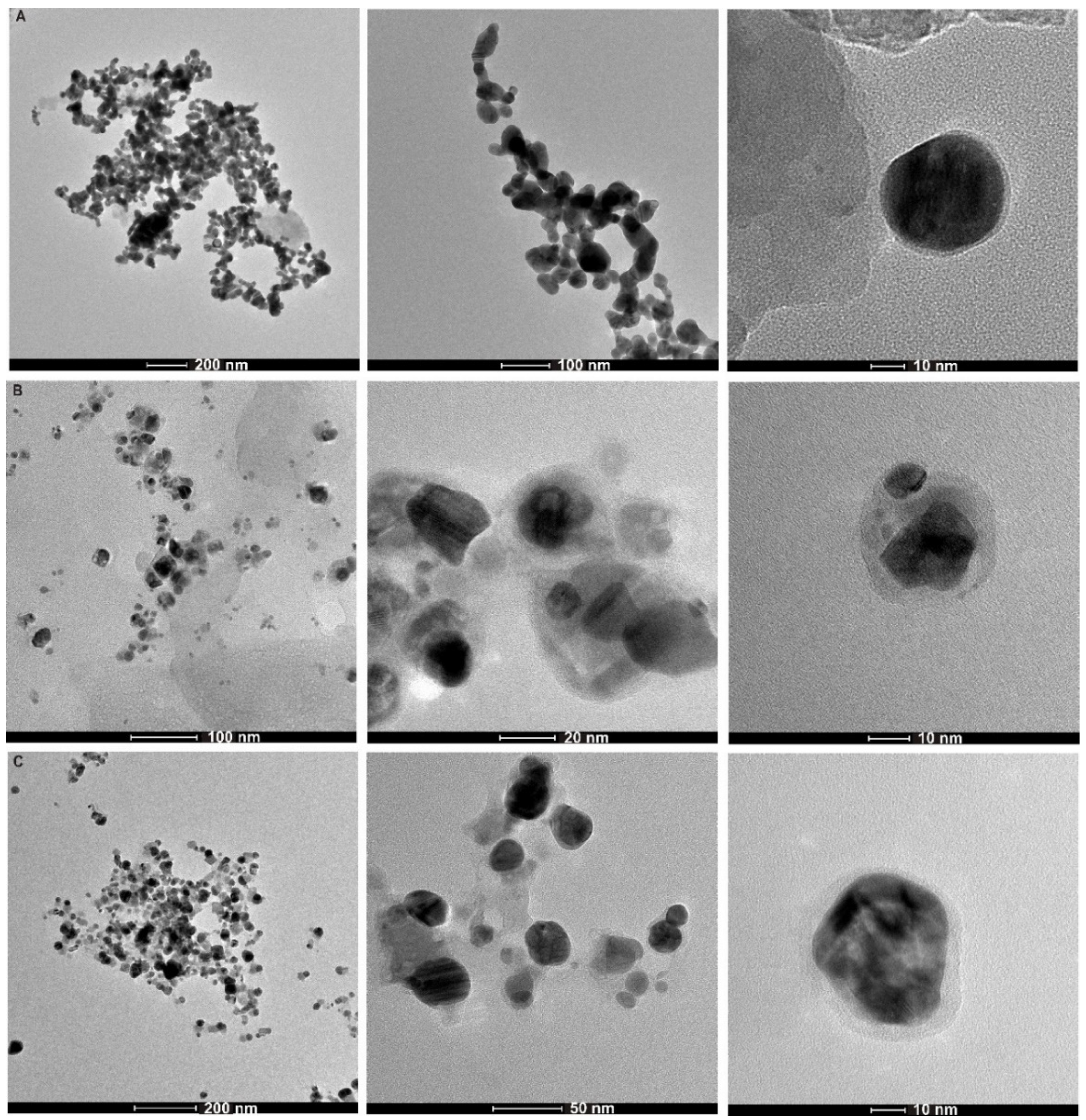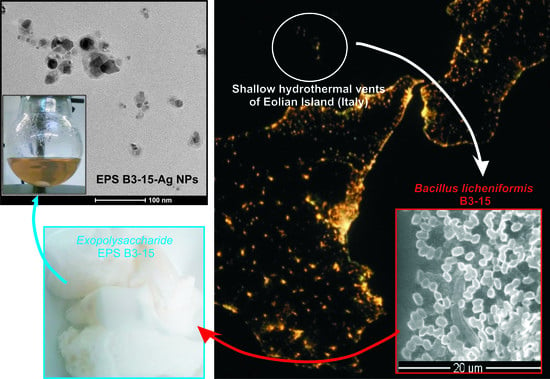Marine Bacterial Exopolymers-Mediated Green Synthesis of Noble Metal Nanoparticles with Antimicrobial Properties
Abstract
:1. Introduction
2. Materials and Methods
2.1. Materials
2.2. Preparation of EP-Au NPs
2.3. Preparation of EP-Ag NPs
2.4. Preparation of γ-PGA-APA-Ag NPs
2.5. Nanoparticle Characterization
2.6. Antimicrobial Activity
3. Results and Discussion
3.1. Synthesis and Characterization of EP-Au NPs
3.2. Synthesis and Characterization of EP-Ag NPs
3.3. Antimicrobial Activity
4. Conclusions
Author Contributions
Acknowledgments
Conflicts of Interest
References
- Pareek, V.; Bhargava, A.; Gupta, R.; Jain, N.; Panwar, J. Synthesis and applications of noble metal nanoparticles: A review. Adv. Sci. Eng. Med. 2017, 9, 527–544. [Google Scholar] [CrossRef]
- Fratoddi, I. Hydrophobic and hydrophilic Au and Ag nanoparticles. breakthroughs and perspectives. Nanomaterials 2018, 8, 11. [Google Scholar] [CrossRef] [PubMed]
- Zhang, Z.; Lin, P.C. Noble metal nanoparticles: Synthesis, and biomedical implementations. Emerg. Appl. Nanopart. Archit. Nanostruct. 2018, 177–233. [Google Scholar]
- Siddiqi, K.S.; Husen, A.; Rao, R.A.K. A review on biosynthesis of silver nanoparticles and their biocidal properties. J. Nanobiotechnol. 2018, 16, 14. [Google Scholar] [CrossRef] [PubMed]
- Kang, H.; Buchman, J.T.; Rodriguez, R.S.; Ring, H.L.; He, J.; Bantz, K.C.; Haynes, C.L. Stabilization of Silver and Gold Nanoparticles: Preservation and Improvement of Plasmonic Functionalities. Chem. Rev. 2019, 119, 664–699. [Google Scholar] [CrossRef] [PubMed]
- Makvandi, P.; Nikfarjam, N.; Sanjani, N.S.; Qazvini, N.T. Effect of silver nanoparticle on the properties of poly(methylmethacrylate) nanocomposite network made by in situ photoiniferter-mediated photopolymerization. Bull. Mater. Sci. 2015, 38, 1625–1631. [Google Scholar] [CrossRef]
- Fazio, E.; Scala, A.; Grimato, S.; Ridolfo, A.; Grassi, G.; Neri, F. Laser light triggered smart release of silibinin from a PEGylated–PLGA gold nanocomposite. J. Mater. Chem. B 2015, 3, 9023–9032. [Google Scholar] [CrossRef]
- Neri, F.; Scala, A.; Grimato, S.; Santoro, M.; Spadaro, S.; Barreca, F.; Cimino, F.; Speciale, A.; Saija, A.; Grassi, G.; et al. Biocompatible silver nanoparticles nanoparticles embedded in a PEG–PLA polymeric matrix for stimulated laser light drug release. J. Nanopart. Res. 2016, 18, 153. [Google Scholar] [CrossRef]
- Courrol, L.C.; Almeida de Matos, R. Synthesis of Gold Nanoparticles Using Amino Acids by Light Irradiation. In Catalytic Application of Nano-Gold Catalysts; Mishra, N.K., Ed.; IntechOpen: London, UK, 2016; pp. 83–99. [Google Scholar]
- Bollella, P.; Schulz, C.; Favero, G.; Mazzei, F.; Ludwig, R.; Gorton, L.; Antiochia, R. Green Synthesis and Characterization of Gold and Silver Nanoparticles and their Application for Development of a Third Generation Lactose Biosensor. Electroanalysis 2017, 29, 77–86. [Google Scholar] [CrossRef]
- Raveendran, P.; Fu, J.; Wallen, S.L. Completely “Green” Synthesis and Stabilization of Metal Nanoparticles. J. Am. Chem. Soc. 2003, 125, 13940–13941. [Google Scholar] [CrossRef]
- Ghoreishi, S.M.; Behpour, M.; Khayatkashani, M. Green synthesis of silver and gold nanoparticles using Rosa damascena and its primary application in electrochemistry. Phys. E Low Dimens. Syst. Nanostruct. 2011, 44, 97–104. [Google Scholar] [CrossRef]
- Ronavari, A.; Igaz, N.; Gopisetty, M.K.; Szerencses, B.; Kovacs, D.; Papp, C.; Vagvolgyi, C.; Boros, I.M.; Konya, Z.; Kiricsi, M.; et al. Biosynthesized silver and gold nanoparticles are potent antimycotics against opportunistic pathogenic yeasts and dermatophytes. Int. J. Nanomed. 2018, 13, 695–703. [Google Scholar] [CrossRef] [PubMed]
- Brayner, R.; Barberousse, H.; Hemadi, M.; Djedjat, C.; Yéprémian, C.; Coradin, T.; Livage, J.; Fiévet, F.; Couté, A. Cyanobacteria as Bioreactors for the Synthesis of Au, Ag, Pd, and Pt Nanoparticles via an Enzyme-Mediated Route. J. Nanosci. Nanotechnol. 2007, 7, 2696–2708. [Google Scholar] [CrossRef] [PubMed]
- Moyo, B.; Oyedemi, S.; Masika, P.J.; Muchenje, V. Polyphenolic content and antioxidant properties of Moringa oleifera leaf extracts and enzymatic activity of liver from goats supplemented with Moringa oleifera leaves/sunflower seed cake. Meat Sci. 2012, 91, 441–447. [Google Scholar] [CrossRef] [PubMed]
- Rasulov, B.A.; Rustamova, N.; Qing, Z.H.; Yili, A.; Aisa, H.A. Synthesis of silver nanoparticles on the basis of low and high molar mass exopolysaccharides of Bradyrhizobium japonicum 36 and its antimicrobial activity against some pathogens. Folia Microbiol. 2016, 61, 283–293. [Google Scholar] [CrossRef] [PubMed]
- Decho, A.W. Microbial exopolymer secretions in ocean environments: Their role(s) in food webs and marine processes. In Oceanography and Marine Biology: An Annual Review; Barnes, M., Ed.; Aberdeen University Press: Aberdeen, UK, 1990; pp. 73–153. [Google Scholar]
- Gugliandolo, C.; Lentini, V.; Spanò, A.; Maugeri, T.L. New bacilli from shallow hydrothermal vents of Panarea Island (Italy) and their biotechnological potential. J. Appl. Microbiol. 2012, 112, 1102–1112. [Google Scholar] [CrossRef] [PubMed]
- Nwodo, U.U.; Green, E.; Okoh, A.I. Bacterial Exopolysaccharides: Functionality and Prospects. Int. J. Mol. Sci. 2012, 13, 14002–14015. [Google Scholar] [CrossRef] [PubMed] [Green Version]
- Raveendran, S.; Chauhan, N.; Palaninathan, V.; Nagaoka, Y.; Yoshida, Y.; Maekawa, T.; Kumar, D.S. Extremophilic Polysaccharide for Biosynthesis and Passivation of Gold Nanoparticles and Photothermal Ablation of Cancer Cells. Part. Part. Syst. Charact. 2015, 32, 54–64. [Google Scholar] [CrossRef]
- Li, C.; Zhou, L.; Yang, H.; Lv, R.; Tian, P.; Li, X.; Zhang, Y.; Chen, Z.; Lin, F. Self-Assembled Exopolysaccharide Nanoparticles for Bioremediation and Green Synthesis of Noble Metal Nanoparticles. ACS Appl. Mater. Interfaces 2017, 9, 22808–22818. [Google Scholar] [CrossRef]
- Vidya, S.M.; Mutalik, S.; Bhat, K.U.; Huilgol, P.; Avadhani, K. Preparation of gold nanoparticles by novel bacterial exopolysaccharide for antibiotic delivery. Life Sci. 2016, 153, 171–179. [Google Scholar]
- Sathiyanarayanana, G.; Vigneshb, V.; Saibabac, G.; Vinothkannad, A.; Dineshkumare, K.; Viswanathana, M.B.; Selvin, J. Synthesis of carbohydrate polymer encrusted gold nanoparticles using bacterial exopolysaccharide: A novel and greener approach. RSC Adv. 2014, 4, 22817–22827. [Google Scholar] [CrossRef]
- Bhat, K.U.; Vidya, S.M. Nisin gold nanoparticles assemble as potent antimicrobial agent against Enterococcus faecalis and Staphylococcus aureus clinical isolates. J. Drug Deliv. Sci. Technol. 2017, 37, 20–27. [Google Scholar]
- Rasulov, B.A.; Davranovc, K.D.; Jun, L.W. Formation of Ag/AgCl Nanoparticles in the Matrix of the Exopolysaccharide of a Diazotrophic Strain Azotobacter chroococcum XU1. Microbiology 2017, 86, 197–201. [Google Scholar] [CrossRef]
- Rasulov, B.A.; Pattaeva, M.A.; Yili, A.; Aisa, H.A. Polysaccharide-based bioflocculant template of a diazotrophic Bradyrhizobum japonicum 36 for controlled assembly of AgCl nanoparticles. Int. J. Biol. Macromol. 2016, 89, 682–688. [Google Scholar] [CrossRef] [PubMed]
- Rasulov, B.A.; Rozi, P.; Mohichehra, A.; Pattaeva, M.A.; Yili, A.; Aisa, H.A. Exopolysaccharide-Based Bioflocculant Matrix of Azotobacter chroococcum XU1 for Synthesis of AgCl Nanoparticles and Its Application as a Novel Biocidal Nanobiomaterial. Materials 2016, 9, 528. [Google Scholar] [CrossRef]
- Caccamo, M.T.; Zammuto, V.; Gugliandolo, C.; Madeleine-Perdrillat, C.; Spanò, A.; Magazù, S. Thermal restraint of a bacterial exopolysaccharide of shallow vent origin. Int. J. Biol. Macromol. 2018, 114, 649–655. [Google Scholar] [CrossRef] [PubMed]
- Gugliandolo, C.; Spanò, A.; Maugeri, T.; Poli, A.; Arena, A.; Nicolaus, B. Role of bacterial exopolysaccharides as agents in counteracting immune disorders induced by herpes virus. Microorganisms 2015, 3, 464–483. [Google Scholar] [CrossRef]
- Maugeri, T.L.; Gugliandolo, C.; Caccamo, D.; Panico, A.; Lama, L.; Gambacorta, A.; Nicolaus, B. A halophilic thermotolerant Bacillus isolated from a marine hot spring able to produce a new exopolysaccharide. Biotechnol. Lett. 2002, 24, 515–519. [Google Scholar] [CrossRef]
- Spanò, A.; Gugliandolo, C.; Lentini, V.; Maugeri, T.L.; Anzelmo, G.; Poli, A.; Nicolaus, B. A Novel EPS-producing Strain of Bacillus licheniformis isolated from a shallow vent off Panarea Island (Italy). Curr. Microbiol. 2013, 67, 21–29. [Google Scholar] [CrossRef]
- Poli, A.; Gugliandolo, C.; Spanò, A.; Taurisano, V.; Di Donato, P.; Maugeri, T.L.; Nicolaus, B.; Arena, A. Poly-γ-Glutamic Acid from Bacillus horneckiae strain APA of shallow marine vent origin with antiviral and immunomodulatory effects against Herpes Simplex Virus Type-2. J. Mar. Sci. Res. Dev. 2015, 5, 173. [Google Scholar] [CrossRef]
- Quality Manual Document M07-A6; CLSI-Clinical Laboratory Standards Institute: Wayne, PA, USA, 2009.
- Fissan, H.; Ristig, S.; Kaminski, H.; Asbach, C.; Epple, M. Comparison of different characterization methods for nanoparticle dispersions before and after aerosolization. Anal. Methods 2014, 6, 7324–7334. [Google Scholar] [CrossRef] [Green Version]
- Mahl, D.; Diendorf, J.; Meyer-Zaika, W.; Epple, M. Possibilities and limitations of different analytical methods for the size determination of a bimodal dispersion of metallic nanoparticles. Coll. Surf. A Physicochem. Eng. Asp. 2011, 377, 386–392. [Google Scholar] [CrossRef]
- Makvandi, P.; Ali, G.W.; Della Sala, F.; Abdel-Fattah, W.I.; Borzacchiello, A. Biosynthesis and characterization of antibacterial thermosensitive hydrogels based on corn silk extract, hyaluronic acid and nanosilver for potential wound healing. Carbohydr. Polym. 2019. [Google Scholar] [CrossRef]
- Chernousova, S.; Epple, M. Silver as Antibacterial Agent: Ion, Nanoparticle, and Metal. Angew. Chem. Int. Ed. 2013, 52, 1636–1653. [Google Scholar] [CrossRef] [PubMed]
- MacCuspie, R.I.; Allen, A.J.; Martin, M.N.; Hackley, V.A. Just add water: Reproducible singly dispersed silver nanoparticle suspensions on-demand. J. Nanopart. Res. 2013, 15, 1760. [Google Scholar] [CrossRef]



| Site | Depth (m) | T (°C) | pH | Conductivity (mS/cm−1) | Strain | References |
|---|---|---|---|---|---|---|
| Bottaro, Panarea Island | 8.0 | 55 | 5.4 | 42.9 | T14 | [31] |
| Campo 7, Panarea Island | 21.3 | 60 | 4.9 | 49.2 | APA | [32] |
| Porto Levante, Vulcano Island | 0.7 | 70 | 5.2 | - | B3-15 | [30] |
| Samples | S. aureus | E. coli | P. aeruginosa | C. albicans | ||||
|---|---|---|---|---|---|---|---|---|
| MIC a | MBC b | MIC | MBC | MIC | MBC | MIC | MFC c | |
| AgNO3 | 31.25 | 31.25 | 15.62 | 15.62 | 7.81 | 7.81 | 15.62 | 125 |
| γ-PGA-APA | - d | - | - | - | n.d. e | n.d. | - | - |
| EPS T14 | - | - | - | - | - | - | - | - |
| EPS B3-15 | - | - | - | - | - | - | - | - |
| γ-PGA-APA-Au | - | - | 45 | - | n.d. | n.d. | - | - |
| EPS T14-Au | - | - | 22.5 | - | n.d. | n.d. | - | - |
| EPS B3-15-Au | - | - | 22.5 | - | n.d. | n.d. | - | - |
| γ-PGA-APA-Ag | - | - | - | - | n.d. | n.d. | - | - |
| EPS T14-Ag | 45 | - | 11.25 | 11.25 | 22.5 | 22.5 | 11.25 | 45 |
| EPS B3-15-Ag | 22.5 | 22.5 | 11.25 | 11.25 | 11.25 | 11.25 | 11.25 | 45 |
| Samples | S. aureus | E. coli | C. albicans | |||
|---|---|---|---|---|---|---|
| MIC | MBC | MIC | MBC | MIC | MFC | |
| EPS T14-Ag lyophil. | 37.5 | 75 | 18.75 | 18.75 | 9.37 | 37.5 |
| EPS B3-15-Ag lyophil. | 18.75 | 37.5 | 18.75 | 18.75 | 9.37 | 37.5 |
© 2019 by the authors. Licensee MDPI, Basel, Switzerland. This article is an open access article distributed under the terms and conditions of the Creative Commons Attribution (CC BY) license (http://creativecommons.org/licenses/by/4.0/).
Share and Cite
Scala, A.; Piperno, A.; Hada, A.; Astilean, S.; Vulpoi, A.; Ginestra, G.; Marino, A.; Nostro, A.; Zammuto, V.; Gugliandolo, C. Marine Bacterial Exopolymers-Mediated Green Synthesis of Noble Metal Nanoparticles with Antimicrobial Properties. Polymers 2019, 11, 1157. https://doi.org/10.3390/polym11071157
Scala A, Piperno A, Hada A, Astilean S, Vulpoi A, Ginestra G, Marino A, Nostro A, Zammuto V, Gugliandolo C. Marine Bacterial Exopolymers-Mediated Green Synthesis of Noble Metal Nanoparticles with Antimicrobial Properties. Polymers. 2019; 11(7):1157. https://doi.org/10.3390/polym11071157
Chicago/Turabian StyleScala, Angela, Anna Piperno, Alexandru Hada, Simion Astilean, Adriana Vulpoi, Giovanna Ginestra, Andreana Marino, Antonia Nostro, Vincenzo Zammuto, and Concetta Gugliandolo. 2019. "Marine Bacterial Exopolymers-Mediated Green Synthesis of Noble Metal Nanoparticles with Antimicrobial Properties" Polymers 11, no. 7: 1157. https://doi.org/10.3390/polym11071157







